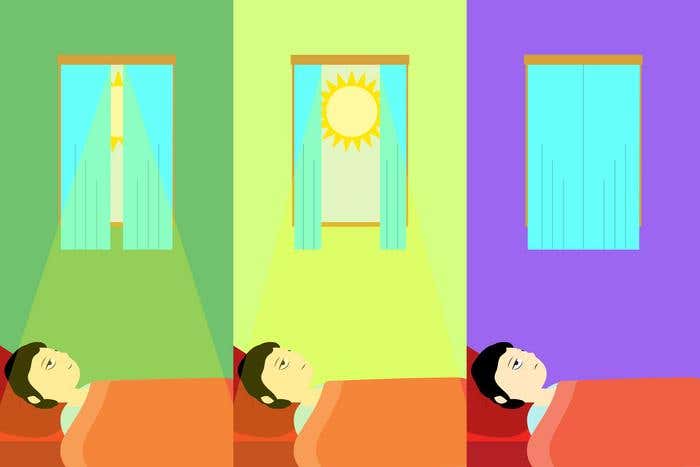How light and city design are shaping healthier, happier lives
How natural light and urban design work together to improve sleep, rents, and daily well-being.

New research links morning light exposure and human-centered city design to better sleep, improved well-being, and smarter housing policies. (CREDIT: Osaka Metropolitan University)
Getting a good night’s sleep isn’t as simple as closing your eyes. In today’s fast-paced world, sleep often takes a back seat to technology, late-night work, and social obligations. But what if the secret to waking up more alert and feeling better rested had less to do with bedtime and more to do with the light in your room—and even the way your city is built?
Recent research, published in the journal, Building and Environment, suggests that natural light, especially in the moments just before waking up, can have a powerful effect on how alert you feel in the morning. At the same time, a new push toward “human-centered” urban design is transforming how neighborhoods shape health, sleep, and even housing costs. Scientists and urban planners are working together to find ways to make homes and cities more supportive of everyday life, from the quality of sleep to how much you pay in rent.
Modern sleep studies often use artificial lighting because it’s easier to control. However, artificial light doesn’t perfectly mimic the gradual increase in brightness that happens naturally during sunrise. To test if natural light could improve how people wake up, researchers at a university in Japan created a simple yet revealing experiment.
Led by Professor Daisuke Matsushita and graduate student Xiaorui Wang, the research team studied 19 people under three different morning lighting conditions. The first group (IA) experienced a slow introduction of natural light for 20 minutes before waking. The second group (IB) was exposed to natural light from the moment the sun rose. The last group (CC) had no natural light at all before waking.
Participants’ levels of alertness, sleepiness, and fatigue were measured using brainwave and heart activity monitors, along with post-wake surveys. The results were clear: people exposed to a moderate amount of natural light just before waking up (the IA group) felt the least sleepy and most alert. The IB group also showed some improvement, but too much early light actually caused a few unwanted effects.
“Our goal is to learn how to control natural light as it changes throughout the year and the day,” said Professor Matsushita. “We want to find the most comfortable and effective way to use it for better awakenings.”
The findings are more than just interesting—they suggest that small changes in home design could improve how people start their day. That might mean using special curtains, setting up beds to face windows, or even building smarter homes that adjust light automatically.
Related Stories
While controlling bedroom light can improve sleep, another force plays a big role in your quality of life: your neighborhood.
Urban development is now focusing more on “sustainable” and “human-centered” design. The idea is simple: cities should be built for the people who live in them. That includes creating environments where people feel safe, connected, and calm—and where things like sleep and well-being aren’t compromised by noise, pollution, or poor planning.
City design shapes your daily habits. Whether it’s how far you walk to the store or how noisy your street is, the built environment affects your mental health, stress levels, and even your sense of belonging. The United Nations’ Sustainable Development Goals highlight these concerns, especially in Goal 11, which urges cities to be inclusive, safe, resilient, and sustainable.
In recent years, researchers have focused on how people perceive their surroundings. Do they feel secure walking home at night? Do they enjoy their view from the window? These “subjective perceptions” might sound personal, but they influence everything from well-being to property values.
By studying these perceptions, researchers hope to help architects, landlords, and city planners build places that feel better to live in—and in turn, actually are better to live in.
When it comes to housing, there’s a difference between owning and renting. Buyers care about long-term factors like neighborhood growth and resale value. Renters, on the other hand, are usually more focused on daily life.
For renters, things like noise levels, safety, public transit, and the condition of the apartment matter more. They also care about the age of the building, whether it has working elevators, and if the appliances are up to date.
Because renters tend to move more often, they’re sensitive to the immediate quality of their surroundings. This makes their decisions about where to live more closely tied to how they feel in a space. That’s why rental prices can often reflect these perceptions more directly than home sale prices do.
One recent study aimed to dig deeper into what really drives rental costs. It included not only usual data like apartment size and location, but also used machine learning to analyze street-level images. These images were used to detect how clean, green, or lively a neighborhood looked—factors that play a large role in how people feel about where they live.
The researchers then built a detailed model, known as a “hedonic price model,” to predict how different features impacted rent. This included the building’s age, access to parks and bus stops, and how attractive the street appeared in photos. These findings help explain why two apartments of the same size might rent for very different amounts.
There’s a practical reason to care about these discoveries. In many cities, housing is becoming harder to afford. If landlords and city planners can learn which features make the biggest difference in perceived value, they can design better housing without driving up costs.
For example, if renters are more willing to pay for units in quieter or greener neighborhoods, developers can prioritize those features. If aging elevators or poor lighting drive down renter satisfaction, then simple improvements in these areas could raise rental value—and improve lives.
In low-income areas, this research can also help reduce housing burdens. Developers can avoid overinvesting in features that don’t matter much to renters and instead focus on what really does—like safety, good lighting, or better access to public transportation. Policymakers can also use these insights to make smarter zoning and infrastructure decisions.
Most importantly, this approach aligns with broader sustainability goals. Human-centered cities don’t just look good on paper—they improve how people sleep, move, and thrive. Even something as basic as how your bedroom fills with morning light can reflect a shift toward healthier, more thoughtful urban living.
By combining data on human behavior, science, and design, a new picture of urban life is taking shape—one where comfort, affordability, and well-being are no longer in conflict, but part of the same solution.
Note: The article above provided above by The Brighter Side of News.
Like these kind of feel good stories? Get The Brighter Side of News' newsletter.



